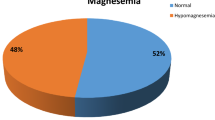Abstract
Osteoporosis that develops during immobli-zation is a severe condition that confers increased risk of fractures with their burden of mortality and disability. The aim of this study was to investigate the determinants of immobilization osteoporosis. As a model of this condition we studied hemiplegic subjects, measuring bone mineral density in the paralyzed lower limb as compared with the non-paralyzed one. In spite of the limits related to the loss of nervous stimulation, this model offers the advantage of a proper control for the complex genetic and environmental cofactors involved. We examined 48 hemiplegic subjects (31 men, 17 women in menopause) admitted consecutively over a 9-month period. Mean length of immobilization was 10.9 months for men (range 1–48 months) and 7.8 months for women (range 1–40 months). The average time since menopause was 14.9 years (range 1.7–23.9 years). For each subject the following were performed: questionnaire, medical examination, anthropometric measurements, evaluation of the scores for spasticity and for lower limb motor capacity in order to account for the different degrees of disability among patients. Bone mineral density was measured using dual-energy X-ray absorptiometry (DXA) at both femoral necks. For each patient we defined a percentage difference in bone loss between the paralyzed and non-paralyzed limb. Regression coefficient were calculated by multiple logistic regression. There was significant bone loss in the paralyzed limb in both sexes, accounting for up to 6.3% in women. Multiple regression analysis showed that the degree of bone loss depends significantly and directly on the length of immobilization, even when controlling for age and sex in the regression model (R=0.193,p=0.034). However, when time since menopause was included in the regression model, with length of immobility as a covariate, it was the only significant determinant of bone loss (R=0.312,p=0.039). No additional factors were observed among men. No differences were shown with regard to anthropometric measurements or functional scores. Length of immobilization accounts only for a small fraction of bone loss, which does not exceed 5% of the total variance. Our data show that postmenopausal women should be considered at highest risk for osteoporosis in cases of immobility and that different factors, other than length of immobility, might come into play in determining bone loss in this condition.
Similar content being viewed by others
References
Minaire P. Immobilization osteoporosis: a review. Clin Rheumatol 1989;8:95–101.
Avoli LV. Significance of osteoporosis: a growing international health care problem. Calcif Tissue Int 1991;49(Suppl):S5–7.
Chiu KY, Pun WK, Lud KD, Chow SP. A prospective study on hip fractures in patients with previous cerebrovascular accidents. Injury 1992;23:297–9.
Donaldson CL, Hulley SB, Vogel JM, Hattner RS, Bayers JH, McMillan DE. Effect of prolonged bed rest on bone mineralization. Metabolism 1970;19:1071–84.
Rodan GA, Thompson DD, Weinreb M. Characterization and pharmacological control of immobilization-induced bone resorption. In: Christiansen C, Johansen JS. Riis BJ, editors. Osteoporosis 1987. Copenhagen, Denmark: Osteopress, 1987:762–6.
Uhthoff HK, Jaworski ZFG. Bone loss in response to long-term immobilization. J Bone Joint Surg [Br] 1978;60:420–9.
Rambaut PC, Goode AW. Skeletal changes during space flight. Lancet 1985;4:1050–2.
Hamdy RC, Krishnaswamy G, Cancellaro V, Whalen K, Harvill L. Changes in bone mineral content and density after stroke. Am J Phys Med Rehabil 1993;72:188–91.
Iversen E, Hassager C, Christiansen C. The effect of hemiplegia on bone mass and soft tissue body composition. Acta Neurol Scand 1989;79:155–9.
Gluer CC, Faulkner KG, Estilo MJ, Engelke K, Rosin J, Genant HK. Quality assurance for bone densitometry research studies: concept and impact. Osteoporosis Int 1993;3:227–35.
Ashworth B. Preliminary trials of carisoprodal in multiple sclerosis. Practitioner 1964;192:540–2.
Lindmark B, Hamrin E. Evaluation of functional capacity after stroke as a basis for active intervention: presentation of a modified chart for motor capacity assessment and its reliability. Scand J Rehabil Med 1988;20:103–9.
Mazess RB. Bone densitometry of the axial skeleton. Orthop Clin North Am 1990;21:51–63.
Kahn HA, Sempos CT. Statistical methods in epidemiology. New York: Oxford University Press, 1989:137–67.
Elias AN, Gwinup G. Immobilization osteoporosis in paraplegia. J Am Paraplegia Soc 1992;15:163–70.
Whedon GD. Disuse osteoporosis: physiological aspects. Calcif Tissue Int 1984;36:146–50.
Reid IR, Ames R, Evans MC, Sharpe S, Gamble G, France JT, Lim TMT, Cundy TF. Determinants of total body and regional bone mineral density in normal postmenopausal women: a key role for fat mass. J Clin Endocrinol Metab 1992;75:45–51.
Barzel US. Estrogens in the prevention and treatment of postmenopausal osteoporosis: a review. Am J Med 1988;85:847–50.
Girasole G, Jilka RL, Passed G, Boswell S, Boder G, Williams DC, Manolagas SC. 17β-Estradiol inhibits interleukin-6 production by bone marrow-derived stromal cells and osteoblasts in vitro: a potential mechanism for the antiosteoporotic effect of estrogens. J Clin Invest 1992;89:883–91.
Author information
Authors and Affiliations
Rights and permissions
About this article
Cite this article
del Puente, A., Pappone, N., Mandes, M.G. et al. Determinants of bone mineral density in immobilization: A study on hemiplegic patients. Osteoporosis Int 6, 50–54 (1996). https://doi.org/10.1007/BF01626538
Received:
Accepted:
Issue Date:
DOI: https://doi.org/10.1007/BF01626538




